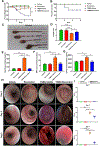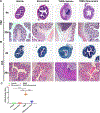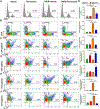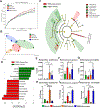Resveratrol modulates the gut microbiota to prevent murine colitis development through induction of Tregs and suppression of Th17 cells
- PMID: 30897248
- PMCID: PMC6863607
- DOI: 10.1002/JLB.3A1218-476RR
Resveratrol modulates the gut microbiota to prevent murine colitis development through induction of Tregs and suppression of Th17 cells
Abstract
Inflammatory diseases of the gastrointestinal tract are often associated with microbial dysbiosis. Thus, dietary interactions with intestinal microbiota, to maintain homeostasis, play a crucial role in regulation of clinical disorders such as colitis. In the current study, we investigated if resveratrol, a polyphenol found in a variety of foods and beverages, would reverse microbial dysbiosis induced during colitis. Administration of resveratrol attenuated colonic inflammation and clinical symptoms in the murine model of 2,4,6-trinitrobenzenesulfonic acid (TNBS)-induced colitis. Resveratrol treatment in mice with colitis led to an increase in CD4+ FOXP3+ and CD4+ IL-10+ T cells, and a decrease in CD4+ IFN-γ+ and CD4+ IL-17+ T cells. 16S rRNA gene sequencing to investigate alterations in the gut microbiota revealed that TNBS caused significant dysbiosis, which was reversed following resveratrol treatment. Analysis of cecal flush revealed that TNBS administration led to an increase in species such as Bacteroides acidifaciens, but decrease in species such as Ruminococcus gnavus and Akkermansia mucinphilia, as well as a decrease in SCFA i-butyric acid. However, resveratrol treatment restored the gut bacteria back to homeostatic levels, and increased production of i-butyric acid. Fecal transfer experiments confirmed the protective role of resveratrol-induced microbiota against colitis inasmuch as such recipient mice were more resistant to TNBS-colitis and exhibited polarization toward CD4+ FOXP3+ T cells and decreases in CD4+ IFN-γ+ and CD4+ IL-17+ T cells. Collectively, these data demonstrate that resveratrol-mediated attenuation of colitis results from reversal of microbial dysbiosis induced during colitis and such microbiota protect the host from colonic inflammation by inducing Tregs while suppressing inflammatory Th1/Th17 cells.
Keywords: 2,4,6-trinitrobenzenesulfonic acid; T helper cells; butyrate; fecal transfer; inflammation; short-chain fatty acid.
©2019 Society for Leukocyte Biology.
Conflict of interest statement
Figures






References
-
- Singh UP, Singh NP, Singh B, Hofseth LJ, Price RL, Nagarkatti M, Nagarkatti PS (2010) Resveratrol (trans-3,5,4’-trihydroxystilbene) induces silent mating type information regulation-1 and down-regulates nuclear transcription factor-kappaB activation to abrogate dextran sulfate sodium-induced colitis. The Journal of pharmacology and experimental therapeutics 332, 829–39. - PMC - PubMed
-
- Carbonnel F and Boutron MC (2017) Incidence, phenotype and mortality of inflammatory bowel disease twenty years after. Journal of Crohn’s & colitis. - PubMed
-
- Bequet E, Sarter H, Fumery M, Vasseur F, Armengol-Debeir L, Pariente B, Ley D, Spyckerelle C, Coevoet H, Laberenne JE, Peyrin-Biroulet L, Savoye G, Turck D, Gower-Rousseau C, Group E (2017) Incidence and Phenotype at Diagnosis of Very-early-onset Compared with Later-onset Paediatric Inflammatory Bowel Disease: A Population-based Study [1988–2011]. Journal of Crohn’s & colitis 11, 519–526. - PubMed
-
- Yadav P, Ellinghaus D, Remy G, Freitag-Wolf S, Cesaro A, Degenhardt F, Boucher G, Delacre M, International IBDGC, Peyrin-Biroulet L, Pichavant M, Rioux JD, Gosset P, Franke A, Schumm LP, Krawczak M, Chamaillard M, Dempfle A, Andersen V (2017) Genetic Factors Interact With Tobacco Smoke to Modify Risk for Inflammatory Bowel Disease in Humans and Mice. Gastroenterology 153, 550–565. - PMC - PubMed
-
- Singh NP, Hegde VL, Hofseth LJ, Nagarkatti M, Nagarkatti P (2007) Resveratrol (trans-3,5,4’-trihydroxystilbene) ameliorates experimental allergic encephalomyelitis, primarily via induction of apoptosis in T cells involving activation of aryl hydrocarbon receptor and estrogen receptor. Molecular pharmacology 72, 1508–21. - PMC - PubMed
Publication types
MeSH terms
Substances
Grants and funding
LinkOut - more resources
Full Text Sources
Research Materials

